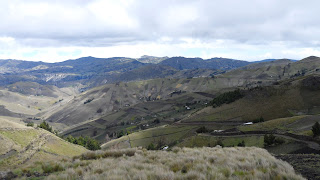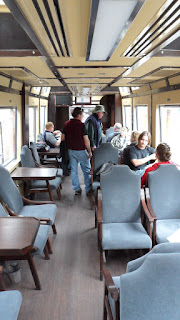As I mentioned in the last entry, the place we stayed in Salcedo was so cool in an Ecuadorian way. It's called Rumipamba de los Rosos,
and it appears to be one of those old haciendas you occasionally find that was converted into a hotel after the majority of the land surrounding it has been sold off. Our room was large and excellent and had a fireplace that was thoroughly enjoyed after a long day.
What made this place so interesting were the grounds. The spaces around the rooms were meticulously manicured,
but a walk around the surrounding grounds revealed, in addition to horses, ponies, and a random ill-tempered ostrich, a hodgepodge of curiosities.
How many hotels have an airplane in the front yard?
On the way to the Quilotoa crater lake, in addition to more spectacular scenery,
we got to do something really special. Our tour guide Juan has a friendship with a local indigenous family, and we were allowed to visit their mud hut home, which is called a "choza."
I don't think this igloo-shaped structure could have been even 15' in diameter, and 12 people lived there. Pitch black inside and lit with a single candle, the primitive life we witnessed was amazing. Guinea pigs roam freely around the home and are held close for warmth at night (and occasionally eaten, of course).
This tiny space is the "kitchen."
The grandfather proudly showed us the device he uses to grind flour.
And family members were proud to pose outside before we left.
We felt so honored to visit here because even most Ecuadorians will never have this experience. The happiness of the family in such crude surroundings was quite humbling.
Then on to Quilotoa crater lake, once again surrounded by remarkable vistas, including White Canyon, a geological oddity.
Quilotoa is the westernmost volcano in the Ecuadorian Andes. The two mile wide lake was formed after an eruption 800 years ago.
It was damned cold up there, and the descent into the canyon was steep and slippery because of the sandy soil. Still, we figured we wouldn't be back here anytime soon, so down we went.
We hiked down for about 30 minutes until the terrain became too challenging. Here's a video I took of our view (sorry about the wind noise):
After this remarkable excursion it was on to Quito, Ecuador's capitol and our final stop. Along the way we saw mighty Cotapaxi, the Mac Daddy volcano of the Andes.
We took a night tour of Quito's historic district, then ended our journey visiting some stunning churches.
Think the Temple of la Compania de Jesus looks ornate on the outside? It is estimated the inside walls are adorned with up to 7 tons of gold!!
We relaxed and reflected on the privilege of living in such a gorgeous country on our return drive to Cuenca. What an adventure!!
Monday, May 28, 2012
Saturday, May 26, 2012
Avenue of the Volcanoes---Day 2
We awoke to discover this lovely waterfall outside our terrace welcoming us through the morning mist.
This turned out to be a preview of the treats we had in store, because after an early breakfast we were off to see the Route of the Waterfalls. It's not hard to guess how this road got its name.
Our destination was the well-known Pailon del Diablo (Devil's Cauldron) waterfall, but on the way we noticed an awesome zipline adventure across a L-O-N-G and D-E-E-P river gorge. Next thing you know, much to the amazement of our guide, we're suited up and ready to rumble.
Here's my first ever blog video of Cynthia's ride:
Pretty cool, huh?
Once we got to our destination, we had to hike down, down, down to the bottom of the waterfall.
The Devil's Cauldron is one powerful force of nature.
After viewing the waterfall we enjoyed a delicious lunch in a beautiful setting.
Good thing we did. The hike back sure seemed longer than the one going down. Here's a look back at the place we ate lunch.
We spent the afternoon exploring Banos, the adventure capital of Ecuador.
With activities like canyoning, white water rafting, horseback riding, ATV'ing, and jungle tours, as well as more relaxing thermal pools and spa treatments, this town is a destination all to itself. We'll definitely be back here for more fun!
We're learning that different towns in Ecuador are known for specific things. Banos, in addition to being an adventure center, is also renowned for its taffy.
Another oddity like this was awaiting us in Pelileo, our next stop. On the way we saw Tungurahua, an active volcano outside Banos.
Pelileo is the "blue jean capital of Ecuador."
Who knew there could be such a place?? People come from all over the country to shop at the dozens of stores here. Could any of these possibly fit anyone you know?
Before leaving I was able to capture a pic of the rarely photographed "Tomb of the Unknown Mannequin."
We rolled into Salcedo late and checked into a wonderful, quirky hacienda. Pics of that in the next blog as well as a visit to a very unusual lake and mighty Cotopaxi volcano.
This turned out to be a preview of the treats we had in store, because after an early breakfast we were off to see the Route of the Waterfalls. It's not hard to guess how this road got its name.
Our destination was the well-known Pailon del Diablo (Devil's Cauldron) waterfall, but on the way we noticed an awesome zipline adventure across a L-O-N-G and D-E-E-P river gorge. Next thing you know, much to the amazement of our guide, we're suited up and ready to rumble.
Here's my first ever blog video of Cynthia's ride:
Pretty cool, huh?
Once we got to our destination, we had to hike down, down, down to the bottom of the waterfall.
The Devil's Cauldron is one powerful force of nature.
After viewing the waterfall we enjoyed a delicious lunch in a beautiful setting.
Good thing we did. The hike back sure seemed longer than the one going down. Here's a look back at the place we ate lunch.
We spent the afternoon exploring Banos, the adventure capital of Ecuador.
With activities like canyoning, white water rafting, horseback riding, ATV'ing, and jungle tours, as well as more relaxing thermal pools and spa treatments, this town is a destination all to itself. We'll definitely be back here for more fun!
We're learning that different towns in Ecuador are known for specific things. Banos, in addition to being an adventure center, is also renowned for its taffy.
Another oddity like this was awaiting us in Pelileo, our next stop. On the way we saw Tungurahua, an active volcano outside Banos.
Pelileo is the "blue jean capital of Ecuador."
Who knew there could be such a place?? People come from all over the country to shop at the dozens of stores here. Could any of these possibly fit anyone you know?
Before leaving I was able to capture a pic of the rarely photographed "Tomb of the Unknown Mannequin."
We rolled into Salcedo late and checked into a wonderful, quirky hacienda. Pics of that in the next blog as well as a visit to a very unusual lake and mighty Cotopaxi volcano.
Tuesday, May 22, 2012
Avenue of the Volcanoes--Day 1
Get ready for a visual feast as I share with you a recap of TerraDiversa's "Avenue of the Volcanoes" tour we took last week with seven other adventurers. Ecuador is such an amazingly gorgeous country, and this trip is an absolute "must do" for visitors with sufficient time and all residents. We saw and did so much during our 4 days together that I need to break the journey down into separate days to properly present the experience.
After an early morning pickup at our homes by a roomy and comfortable Mercedes scenic van we were off to ride the Devil's Nose train in Alausi. Shortly out of Cuenca the cameras came out as we were treated to beautiful countryside vistas.
Our talented guide, Juan Munoz, shared interesting information along the way and throughout our excursion.
I cannot emphasize enough how much enrichment a qualified guide adds to a trip like this. I know several friends with their own vehicles have traveled to some of the sights we witnessed. Seeing something is certainly better than not seeing it, but to learn along the way the history, geology, flora and fauna, and culture adds immeasurably to one's experience.
The Devil's Nose train is one of the great railway engineering feats of the late 19th century. Originally part of the rail system connecting Guayaquil with the Andean highlands, an almost vertical gain in altitude at the section known as Nariz del Diablo (Devil's Nose)stalled construction for years. Finally a design was created using a series of switchbacks to traverse the difficult terrain.
We were especially fortunate because the tracks had very recently been upgraded and a brand new, comfortable train put into service.
During the two hour ride once again we gazed out at remarkably exquisite landscapes.
From Alausi we went through more amazing countryside,
(This is quinoa, a high protein grain that grows best at high altitude)
stopping to see the first church built in Ecuador in 1534--only 42 years after Columbus set foot in the Americas. Amazing.
Then it was up, up, up to almost 21,000 feet to view the mighty El Chimborazo mountain and its breathtaking glaciers.
After a l-o-n-g day we rolled into Banos, the adventure capital of Ecuador, for some much needed R&R that evening.
Tomorrow: are you ready for some ziplining?
After an early morning pickup at our homes by a roomy and comfortable Mercedes scenic van we were off to ride the Devil's Nose train in Alausi. Shortly out of Cuenca the cameras came out as we were treated to beautiful countryside vistas.
Our talented guide, Juan Munoz, shared interesting information along the way and throughout our excursion.
I cannot emphasize enough how much enrichment a qualified guide adds to a trip like this. I know several friends with their own vehicles have traveled to some of the sights we witnessed. Seeing something is certainly better than not seeing it, but to learn along the way the history, geology, flora and fauna, and culture adds immeasurably to one's experience.
The Devil's Nose train is one of the great railway engineering feats of the late 19th century. Originally part of the rail system connecting Guayaquil with the Andean highlands, an almost vertical gain in altitude at the section known as Nariz del Diablo (Devil's Nose)stalled construction for years. Finally a design was created using a series of switchbacks to traverse the difficult terrain.
We were especially fortunate because the tracks had very recently been upgraded and a brand new, comfortable train put into service.
During the two hour ride once again we gazed out at remarkably exquisite landscapes.
From Alausi we went through more amazing countryside,
(This is quinoa, a high protein grain that grows best at high altitude)
stopping to see the first church built in Ecuador in 1534--only 42 years after Columbus set foot in the Americas. Amazing.
Then it was up, up, up to almost 21,000 feet to view the mighty El Chimborazo mountain and its breathtaking glaciers.
After a l-o-n-g day we rolled into Banos, the adventure capital of Ecuador, for some much needed R&R that evening.
Tomorrow: are you ready for some ziplining?
Subscribe to:
Comments (Atom)


























































